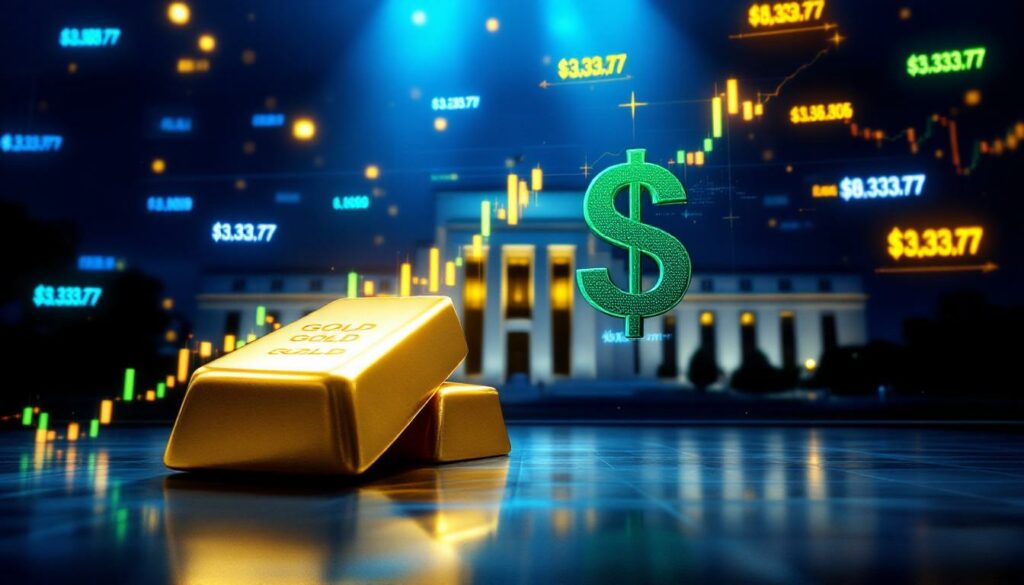How Does the Dollar Strength Impact Gold Prices?
The relationship between gold prices and the US dollar represents one of the most fundamental dynamics in financial markets. Historically, these two assets maintain an inverse correlation that creates significant implications for investors worldwide. When the dollar strengthens against other major currencies, gold typically experiences downward pressure on its price.
The mechanics behind this relationship are straightforward but powerful. Since gold is priced in US dollars globally, a stronger dollar makes the precious metal more expensive for buyers holding other currencies. This higher relative cost reduces demand from international investors, creating selling pressure that drives prices lower.
"When the dollar rises in value, fewer dollars are needed to buy the same amount of gold. This mathematical relationship creates an almost automatic inverse correlation," explains Nitesh Shah, commodities strategist at WisdomTree.
This relationship was clearly demonstrated in July 2025, when spot gold fell 0.6% to $3,335.77 per ounce as the dollar index strengthened by 0.3% against a basket of rival currencies. US gold futures showed an even sharper decline, dropping 0.8% to $3,331.30 during the same period.
Key factors driving this inverse relationship include:
- Interest rate differentials between economies
- Relative economic growth prospects
- Inflation expectations and monetary policy divergence
- Safe-haven capital flows during market uncertainty
While the inverse relationship is the norm, exceptions can occur during periods of extreme market stress when both gold and the dollar attract safe-haven flows simultaneously. These anomalies typically prove temporary as the fundamental relationship reasserts itself once markets stabilize.
What Factors Influence the Gold-Dollar Relationship?
The complex interplay between gold prices and stronger dollar extends beyond simple currency conversion effects. A deeper understanding requires examining the fundamental economic forces that drive this relationship.
Economic Fundamentals Behind the Inverse Correlation
Gold's status as a globally recognized store of value means it responds to a variety of economic indicators. The dollar's role as the world's primary reserve currency similarly makes it sensitive to global economic conditions.
Interest rate differentials play a crucial role in this relationship. When US interest rates rise relative to other economies, the dollar typically strengthens as international capital flows seek higher yields. Simultaneously, higher rates increase the opportunity cost of holding non-yielding assets like gold, creating a double negative impact on gold prices.
This effect is particularly pronounced in the current market environment, where a 1% Federal Reserve rate hike typically strengthens the dollar by 2-3% against baskets of major currencies. This amplification means even modest policy adjustments can trigger significant gold price movements.
Currency values fundamentally reflect relative economic conditions between nations. Countries with stronger growth prospects, lower inflation, and more stable fiscal positions tend to have stronger currencies. When the US economy outperforms global peers, the dollar strengthens—typically at gold's expense.
Central Bank Policy Impacts
Few factors influence the gold-dollar relationship more directly than central bank policy decisions, particularly those made by the Federal Reserve.
The Fed's dual mandate of price stability and maximum employment guides its interest rate decisions, which directly impact:
- Dollar strength through yield differentials
- Gold's opportunity cost as a non-yielding asset
- Market expectations for future economic conditions
- Inflation projections and hedging demand
Central bank communications have become increasingly important in recent years. Forward guidance, policy statements, and press conferences can trigger significant market movements even when actual policy remains unchanged. This "signaling effect" explains why gold often reacts strongly to Fed chair speeches and minutes from policy meetings.
Market sensitivity to leadership changes at central banks can create pronounced volatility. This was demonstrated in July 2025 when gold prices reached all-time highs amid rumors of Federal Reserve Chair Powell's potential dismissal, only to retreat after presidential clarification that no leadership change was planned.
Central bank gold reserves themselves represent another crucial factor. Global central banks added 1,136 tonnes to their gold holdings in 2024, creating significant demand that partially offset dollar-driven price pressures. This institutional buying reflects strategic diversification away from dollar-denominated assets by many emerging market central banks.
Why Did Gold Prices Recently Decline?
Recent Market Movement Analysis
The July 2025 gold market correction offers a textbook example of how dollar strength impacts precious metals. After briefly trading near all-time highs, gold experienced a sharp pullback, dropping 0.6% to $3,335.77 per ounce as the dollar index climbed 0.3% against rival currencies.
This decline wasn't isolated to gold alone. The broader precious metals complex showed similar weakness:
| Metal | Price (July 17, 2025) | Daily Change |
|---|---|---|
| Gold | $3,335.77 | -0.6% |
| Silver | $37.77 | -0.4% |
| Platinum | $1,412.78 | -0.3% |
| Palladium | $1,223.03 | -0.6% |
Technical factors amplified the sell-off. Gold's 20-day moving average at $3,350 functioned as technical resistance, triggering algorithmic selling when breached. According to CME Group analytics, this technical breakdown accelerated the decline as automated trading systems executed sell orders.
"Yesterday, gold prices rose on the back of these rumors, which were unfounded. Since the rumors were quelled, prices have been falling," noted Nitesh Shah, referring to the speculation about Federal Reserve leadership.
Market volatility spiked to 18% intraday during this period of uncertainty, nearly double the typical levels seen in previous months. This heightened volatility created challenging conditions for traders attempting to manage risk exposure.
Political Factors Affecting Market Sentiment
The catalyst for gold's price swing came from an unexpected source: political commentary regarding Federal Reserve leadership. Presidential remarks created momentary uncertainty about Fed Chair Powell's tenure, triggering a flight to gold's perceived safety.
When subsequent clarification indicated no leadership change was planned, markets rapidly repriced both gold and the dollar. This episode demonstrates how politically-induced uncertainty can temporarily override fundamental factors, creating trading opportunities for prepared investors.
Ongoing speculation about potential policy shifts continues to influence trading. Market participants are closely monitoring:
- Future Federal Reserve appointment considerations
- Political rhetoric regarding monetary policy independence
- Election cycle implications for economic policy
- Legislative proposals affecting financial markets
These political dynamics add an additional layer of complexity beyond traditional economic indicators. While the fundamental gold prices and stronger dollar relationship remains intact, political wildcards can create short-term disruptions that sophisticated traders can exploit.
How Do Traders Navigate Gold-Dollar Fluctuations?
Technical Analysis Perspectives
Professional gold traders rely heavily on technical analysis to identify entry and exit points amid dollar-driven volatility. With gold currently trading in a defined range between $3,300 and $3,400, these technical levels have taken on heightened importance.
Key technical indicators that traders monitor include:
- Support levels, particularly $3,300, where buying has consistently emerged
- Resistance at $3,400, which has capped recent rallies
- The 20-day moving average ($3,350), functioning as dynamic support/resistance
- Relative Strength Index (RSI) readings to identify overbought/oversold conditions
- Volume patterns that confirm or contradict price movements
Options market data provides additional insight. Concentrated put options at $3,300 and call options at $3,400 create gravitational pull toward these strikes through "gamma hedging" activities by market makers. When spot approaches $3,300, dealers sell futures to hedge short put positions, potentially accelerating declines.
Historical price patterns suggest gold typically experiences seasonal strength in August through October, regardless of dollar movements. This seasonal tendency has proven reliable in 7 of the past 10 years, offering a potential tailwind for gold despite dollar strength.
Fundamental Indicators to Monitor
While technical analysis guides short-term trading decisions, fundamental indicators drive longer-term price trends. Savvy traders monitor several key data points to anticipate shifts in the gold-dollar relationship:
US employment data, particularly weekly jobless claims and monthly non-farm payrolls, provides insight into labor market health. Strong employment typically strengthens the dollar while weakening gold, as it supports the case for tighter monetary policy.
Retail sales performance offers a window into consumer health, which constitutes roughly 70% of US economic activity. Stronger-than-expected retail data generally benefits the dollar at gold's expense.
Federal Reserve official speeches require careful parsing for policy signals. Even subtle changes in language regarding inflation, employment, or financial stability can trigger significant market moves.
International trade developments have taken on increased importance. The transcript specifically mentioned the August 1 tariff deadline as a potential market-moving event, with Shah noting: "If we come out of August 1 with better trade deals, that could be gold price-negative."
Traders also monitor positioning data from the Commodity Futures Trading Commission (CFTC), which reveals speculative interest in both gold and the dollar. Extreme positioning often precedes price reversals, making this data valuable for contrarian trading strategies.
What Trade Factors Are Influencing Precious Metals Markets?
International Trade Relations Impact
Global trade dynamics have emerged as significant drivers of precious metals markets, creating ripple effects that impact both gold prices and dollar strength.
Potential new trade agreements with countries like India could reshape metal flows and pricing. India represents the world's second-largest gold consumer, with annual demand exceeding 800 tonnes. Trade policy changes affecting this crucial market could significantly impact global gold dynamics.
The transcript specifically highlighted an August 1 tariff deadline as a potential market catalyst. This deadline represents a critical junction for several key trade relationships and could trigger volatility across precious metals markets.
"I think if we come out of the August 1 tariff deadline with much better trade deals, then that could be gold price-negative," explained Shah, highlighting the complex interplay between trade policy and gold prices.
Market sensitivity to trade deal announcements has increased substantially, with algorithms scanning headlines for trade-related keywords. This automated response mechanism can trigger sharp price movements within seconds of major announcements.
Trade tensions often trigger currency volatility, which spills over into gold market surge. When international commerce faces disruption, supply chains for physical gold delivery can experience bottlenecks, creating premiums or discounts in different regions.
Broader Precious Metals Market Trends
While gold commands the spotlight, other precious metals provide valuable context for understanding market dynamics. Each metal responds differently to dollar strength and trade factors due to its unique supply-demand fundamentals.
Silver ($37.77, -0.4%) typically exhibits higher volatility than gold due to its smaller market size and dual role as both precious and industrial metal. Its 0.4% decline alongside gold's 0.6% drop demonstrates this correlation, though silver's industrial applications make it more sensitive to trade disruptions.
Platinum ($1,412.78, -0.3%) shows significant exposure to automotive sector demand, with approximately 40% of annual production used in catalytic converters. Trade restrictions affecting automotive supply chains can dramatically impact platinum prices independently of dollar movements.
Palladium ($1,223.03, -0.6%) demonstrates the highest industrial sensitivity among precious metals, with over 80% of demand coming from automotive applications. Its price volatility often exceeds gold's during trade disputes that threaten vehicle production.
These interconnected markets create trading opportunities beyond simple gold-dollar plays. Spread trades between different precious metals can provide exposure to specific industrial or economic factors while minimizing dollar-related risks.
The Gold/Silver ratio (currently around 88:1) and Gold/Platinum ratio (approximately 2.36:1) serve as important barometers of relative value, with extreme readings often preceding significant price adjustments across the metals complex.
How Should Investors Respond to Gold-Dollar Fluctuations?
Portfolio Diversification Strategies
Strategic investors approach gold differently than traders, focusing on its long-term diversification benefits rather than short-term price movements. Understanding gold's evolving relationship with the dollar helps optimize portfolio construction.
Gold's traditional role as a portfolio diversifier has become more complex. Data from Bloomberg indicates gold's correlation with the S&P 500 flipped from -0.3 to +0.6 during 2020-2025 market crises, reducing its diversification efficacy during certain periods.
Effective diversification strategies include:
- Maintaining baseline allocations of 5-10% to gold during dollar bear markets and 3-5% during dollar bull cycles
- Tactical adjustments based on real interest rate trajectories, which historically explain over 70% of gold's price variance
- Consideration of gold mining equities for leveraged exposure when the gold-to-dollar ratio appears historically favorable
- Utilizing options strategies to hedge dollar-induced volatility while maintaining gold exposure
- Geographic diversification across multiple gold-producing regions to mitigate country-specific risks
Correlation patterns vary significantly across different economic cycles. Gold typically performs best during periods of negative real interest rates, regardless of nominal dollar strength. This nuance is crucial for portfolio optimization during inflationary environments.
Investors should consider gold's place within a broader gold inflation hedge framework that might include Treasury Inflation-Protected Securities (TIPS), commodities, and real estate. Each asset responds differently to dollar fluctuations, creating complementary protection.
Risk Management Approaches
Managing risk exposure to gold-dollar fluctuations requires both technical discipline and fundamental awareness. World Gold Council studies show retail investors consistently underperform gold by 4% annually by buying highs and selling lows, highlighting the importance of systematic risk management.
Effective risk management strategies include:
- Setting appropriate stop-loss levels that account for gold's typical daily volatility (currently averaging 1.2%)
- Position sizing based on correlation analysis between gold and other portfolio assets
- Implementing dollar-cost averaging for building long-term gold positions regardless of currency movements
- Utilizing options strategies such as collars or spreads to define risk parameters
- Diversifying across physical gold, ETFs, mining stocks, and royalty companies to manage specific risks
Sophisticated investors monitor the "shadow rate" model—tracking the gap between inflation and Treasury yields—which explains over 70% of gold's price variance according to IMF research. This model provides a framework for adjusting gold exposure as real rates fluctuate.
Understanding how geopolitical events affect both gold and currency markets allows investors to prepare for potential disruptions. Certain events, such as sovereign debt crises or military conflicts, can trigger simultaneous moves in both gold and the dollar, temporarily breaking their inverse relationship.
Technical indicators provide valuable warning signals for potential trend reversals. The weekly RSI crossing above 70 or below 30 has historically preceded significant gold price reversals with approximately 75% accuracy, offering a useful timing tool for position adjustments.
What Future Catalysts Could Shift the Gold-Dollar Dynamic?
Economic Data Releases to Watch
Several upcoming economic indicators have the potential to significantly impact the gold-dollar relationship. Investors should mark their calendars for these potential market-moving events.
Employment statistics offer insight into labor market health, which directly influences Fed policy decisions. The next non-farm payrolls report could trigger volatility if it deviates significantly from the consensus forecast of 175,000 jobs added.
Inflation indicators, particularly the Personal Consumption Expenditures (PCE) index, provide crucial data on price stability. With the Fed's 2% inflation target serving as a policy anchor, any significant deviation could reshape rate expectations and the gold-dollar dynamic.
Consumer spending metrics offer visibility into economic momentum. Retail sales data for July 2025 will be closely scrutinized for signs of consumer resilience or weakness, with implications for both currency values and safe-haven demand.
Business sentiment surveys like the ISM Manufacturing and Services indices provide forward-looking economic signals. Readings below 50 indicate contraction and could weaken the dollar while potentially supporting gold through safe-haven demand.
The economic calendar features several high-impact releases:
- Weekly jobless claims (every Thursday)
- Monthly non-farm payrolls (first Friday)
- Consumer Price Index (mid-month)
- Federal Reserve Beige Book (eight times annually)
- GDP growth estimates (quarterly)
These releases warrant particular attention as they have historically triggered significant price movements in both gold and the dollar.
Geopolitical Considerations
Beyond economic data, several geopolitical factors could reshape the gold-dollar landscape in coming months.
Trade negotiation outcomes represent a primary focus. The August 1 tariff deadline mentioned in the transcript could significantly impact market sentiment. Successful negotiations might strengthen the dollar and pressure gold, while breakdown in talks could trigger safe-haven flows to both assets.
Political stability in major economies influences risk perceptions. Electoral outcomes, leadership changes, and policy shifts can trigger significant market realignments as investors reassess economic trajectories.
Central bank policy coordination internationally shapes currency relationships. Divergence between Fed policy and other major central banks amplifies dollar movements, while coordinated action tends to stabilize currency relationships and reduce gold volatility.
Supply disruptions in major gold-producing regions can override currency effects temporarily. Mining strikes, regulatory changes, or resource nationalism policies can create supply constraints that push prices higher regardless of dollar strength.
Climate-related disruptions to mining operations represent an emerging risk factor. Extreme weather events increasingly impact production in key regions, creating supply uncertainties that can temporarily override currency-driven price pressures.
These geopolitical considerations require ongoing monitoring, as they can rapidly alter market dynamics. Unlike scheduled economic releases, these events often emerge unexpectedly, creating both risks and opportunities
Ready to Stay Ahead of Major Mineral Discoveries?
Gain immediate notifications on significant ASX mineral discoveries with Discovery Alert's proprietary Discovery IQ model, which transforms complex data into actionable insights for both short-term traders and long-term investors. Visit the Discovery Alert discoveries page to understand how major mineral discoveries can lead to exceptional market returns and begin your 30-day free trial today.




